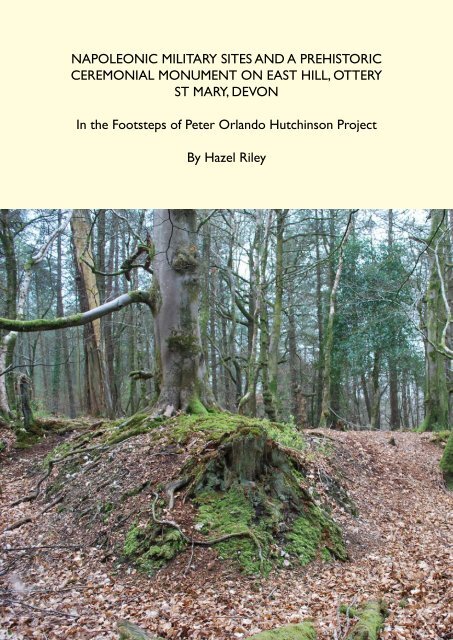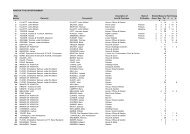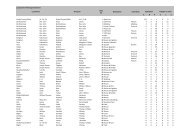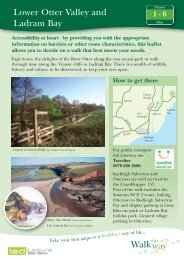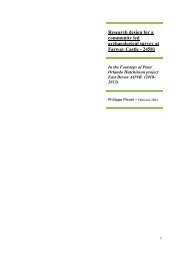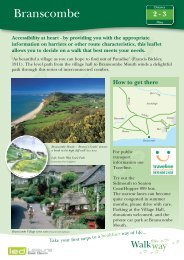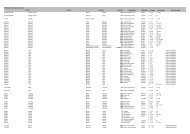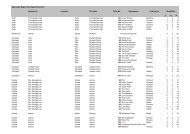NAPOLEONIC MILITARY SITES AND A PREHISTORIC ...
NAPOLEONIC MILITARY SITES AND A PREHISTORIC ...
NAPOLEONIC MILITARY SITES AND A PREHISTORIC ...
You also want an ePaper? Increase the reach of your titles
YUMPU automatically turns print PDFs into web optimized ePapers that Google loves.
<strong>NAPOLEONIC</strong> <strong>MILITARY</strong> <strong>SITES</strong> <strong>AND</strong> A <strong>PREHISTORIC</strong>CEREMONIAL MONUMENT ON EAST HILL, OTTERYST MARY, DEVONIn the Footsteps of Peter Orlando Hutchinson ProjectBy Hazel RileyDate of report: May 2012Copyright: © The authorHazel Riley BA (Hons), AIFA, FSAConsultant in Landscape History, Management and Conservation GrazingThe Furley Herd of Dexter CattleNew House CottageFurleyAxminsterDevonEX13 7TR01404 881330hazelfurleydexter@btinternet.com
ABSTRACTDetailed surveys of three earthworks on East Hill, Ottery St Mary, Devon have resultedin the re-interpretation of two of the sites as late 18 th or early 19 th century earthworkredoubts. The third, previously interpreted as a round barrow, modified for treeplanting, is interpreted as an embanked platform cairn.INTRODUCTIONThe surveys on East Hill are part of the In the Footsteps of Peter Orlando Hutchinsonproject, run by the East Devon AONB and funded by the Heritage Lottery Fund,the Sid Vale Association (Keith Owen Fund), Devon County Council, East DevonDistrict Council and Natural England. This project, building on the work of the recentParishscapes project (East Devon AONB 2010), aims to raise awareness of landscapechange, to help conserve and enhance historical features and to continue the legacy ofvolunteer study and involvement in landscape heritage (www.eastdevonaonb.org.uk/IntheFootstepsofPeterOrlandoHutchinson). The three sites considered here are part ofa suite of earthworks on East Hill which are now largely ‘lost’ in dense woodland andthe work was carried out after the project volunteers carried out clearance, allowingdetailed survey and interpretation work.Location, topography and geologyThe sites lie at SY 1222 9407, SY 1232 9423 and SY 1248 9453 at c 240m OD on theedge of East Hill Strips, part of a narrow ridge forming the watershed between the SidVale and the Otter Valley. They lie on the western edge of the parish of Ottery St Maryand within East Devon AONB (Fig 1). The ridge top of East Hill, here marked by landabove c 230m, is formed from the Upper Greensand sandstone rocks of Cretaceousage, capped by clay, silt, sand and gravel of the Quaternary Clay-With-Flints Formation(British Geological Survey www.bgs.ac.uk). The sites are now within woodland, plantedin the mid-20 th century; prior to this East Hill was common land, enclosed during the19 th century.DevonEast Hill21East Hill Strips3Fig 1 Locationmap1 Cairn2 North redoubt3 South redoubt1East Hill
Hutchinson remarks on the view afforded from the ridge:‘Tired and hot and thirsty, we sat on the slope of the hill to eat our sandwichesand admire the splendid view over the valley of the Otter and the country beyond.I never saw the colouring finer nor the distant view clearer. Every stranger oughtto get to the top of Ottery East Hill, especially in the forenoon, to enjoy this view’(Butler 2010, 8).Numbering of the sitesNorthern redoubtHutchinson 1871 Tumulus H (map published in Butler 2010, 13)Hutchinson 1880 19Grinsell 1983 Round barrow Ottery St Mary 2NMR SY 19 SW 4 (UID 449380)Devon HER 10750Southern redoubtHutchinson 1871 Tumulus G (map published in Butler 2010, 13)Hutchinson 1880 18Grinsell 1983 Round barrow Ottery St Mary 3NMR SY 19 SW 5 (UID 449383)Devon HER 10757Prehistoric monumentHutchinson 1880 20Grinsell 1983 Round Barrow Ottery St Mary 1NMR SY 19 SW 36 (UID 449493)Devon HER 20256EH SAM Heritage Asset List 1017773PREVIOUS WORK: ANTIQUARIAN DESCRIPTIONS, MAP DEPICTIONS<strong>AND</strong> SURVEYSAll three of the sites are depicted on the OS map of 1806, which also shows how theridge was then open, unenclosed common land (Searle 1806) (Fig 2). The sites areshown on the tithe map of Ottery St Mary, dated 1843, where they are shown (in faintink or pencil) as oval (north redoubt and prehistoric monument) and square (southredoubt) enclosures on recently enclosed land called simply ‘Plot on East Hill’ (Fig 3).On the 21 st October 1854 Hutchinson took Mr Heineken and Mr Waterhouse toOttery East Hill. He describes three barrows:‘These barrows are cut into peculiar forms by the ditches made around them. Themost southerly one is in the shape of a star with six points, like a fort or battery;the second is like a square but bounded by curved lines bowing inwards, and themost northerly towards Chineway Head is merely circular. These ditches are notlikely to be ancient and perhaps were made at the time the barrows were plantedwith fir trees, some of which remain growing on them’(Butler 2000, 97).2East Hill
Fig 2 (top left) Extractfrom OS map of 1806(Searle 1806)Fig 3 (top right) Extractfrom Ottery St Marytithe mapFig 4 (left) Hutchinson’splan of ‘Two barrows,Ottery East Hill’ (Butler2000,97)Hutchinson also drew plans of the star-shaped and square monuments (Fig 4; Butler2000, 97).The earthworks are not depicted on the OS 1 st edition map of 1889, but smallpentagonal, rectangular and circular enclosures are shown at their locations, with asingle conifer on the south redoubt, two conifers on the north redoubt and three onthe prehistoric monument (Devon sheet 82 NW).The north redoubt is described as probably a recent fortification in the late 19 thcentury in a report of the Barrow Committee (Hutchinson 1880, 125). In 1977 RJSilvester suggested that the barrow may have been used for the base of the feature, butit (the barrow) had been totally redesigned, with the steep ditch sides suggesting a fairlymodern construction (Devon HER number MDV 10750). The OS Archaeology Division(1982) described the site as a sub-rectangular, flat-topped mound with concave sidesand an enclosing ditch. The Investigator agreed with Hutchinson that the mound was abarrow, re-cut for ornamental purposes (NMR number SY 19 SW 4).The south redoubt was described by the Barrow Committee as a large barrow with astar-shaped enclosure trenched into it, and trees planted on it c 1820 (Hutchinson1880,125). RJ Silvester, on a site visit in 1977, described the site as not a barrow but anornamental mound with a steep-sided ditch and a lower bank beyond (Devon HERnumber MDV 10757). In 1982 the OS Investigator described the site as a ditchedmound, shaped as a six-point star with a surrounding ditch and outer bank, agreeing3East Hill
with Hutchinson that the mound was a barrow, subjected to ornamentation (NMRnumber SY 19 SW 5).Pollard records the prehistoric monument as a ring ditch (1967, fig 1; 1971, fig 1). In1982 the OS Investigator described the site as a tree covered, flattish mound with abank around its edge and an external ditch and interprets it as a flat-topped roundbarrow with modification for ornamental purposes (NMR number SY 19 SW 36).The OS Archaeology Division surveyed all three of the earthworks at a scale of 1:2500in 1982.These surveys, now published as line features on OS MasterMap, remained themost detailed records of the sites until the present study.THE SURVEYSurvey methodThe surveys were carried out in late March 2012 using an EDM to record theearthwork features at a scale of 1:250. Profiles across the sites were also recordedusing the EDM. The surveys were completed in the field using graphical methods. Theartificial slopes are shown by the archaeological convention of hachuring: the top of theslope is indicated by the flat end of the triangle, the bottom of the slope by the end ofthe line.Description of the earthworksThe northern redoubt (Figs 5 and 9)The monument consists of a mound which is roughly square with elongated corners.From corner to corner the mound measures 250m NW/SE and 220m NE/SW andis 1m high. The mound is surrounded by a ditch, 1.4m wide and 0.5m deep, and slightbank, 1-1.6m wide and 0.25m high. The outer bank has been damaged by the car parkto the SW and by the road to the east. The top of the mound is flat (Fig 9) and themound constructed predominantly of earth and local flint. Several beeches and an oaktree grow on the edges of the mound; a tall Scots Pine grows on the SE corner. Thepine is probably one of those recorded on the 19 th century maps and described byHutchinson.The southern redoubt (Figs 6 and 10))The southern redoubt also consists of a roughly square-shaped mound, but thisone has protrusions on its north and south sides, as well as its corners (Fig 10). Themound measures 170m NW/SE and 180m NE/SW and is 1m high. The mound, likethat to north, is made of earth and local flint. It is surrounded by a ditch, 1.2m wideand 0.6m deep, and an outer bank, 1.2m wide and 0.7m high. Both the outer bankand the ditch have been damaged by quarrying on the northern side of the site. Thehollows on the east side of the redoubt are also the result of quarrying. The top ofthe mound is mostly flat, with slight earthworks on the west and south edges, and asmall mound surrounding a Scots Pine tree. Several beech trees grow on the mound.The pine is probably one of those recorded on the 19 th century maps and described byHutchinson.4East Hill
XYScotspine0 20mXYHorizontal scale 1:250Vertical scale 1:125Fig 5 Earthwork survey and profile of the north redoubt (1:250)5East Hill
YX0 20mXYHorizontal scale 1:250Vertical scale 1:125Fig 6 Earthwork survey and profile of the south redoubt (1:250)6East Hill
The prehistoric monument (Figs 7 and 8)The monument comprises an egg-shaped mound, made of earth and flint, whichmeasures 230m N/S and 210m E/W. The mound is 0.75m high and is flat-topped (Fig8). A narrow bank, 0.5m wide and 0.25m high runs around the northern edge of themound. To the south the bank is 1.2m wide and 0.2m high. The ditch surrounding themound is 1.3m wide and 0.6m deep; a very slight outer bank, 1.2m wide and 0.2m high,is visible on the west side of the ditch. Trees grow on the monument, mostly recentlyplanted beech. A Scots Pine is growing on the west side of the mound, this is probablyone of those recorded on the 19 th -century maps and described by Hutchinson.Fig 8 The southside of the cairnINTERPRETATION <strong>AND</strong> DATINGThe previous interpretation of the north and south redoubts as modified barrowmounds is brought into question by these surveys. Both mounds bear little resemblanceto prehistoric burial mounds, whatever modification may have occurred. It is arguedhere that the earthworks were constructed in the late 18 th or early 19 th century as partof military training and were redoubts: standings for gun platforms.There are several strands of evidence which support this. The mounds resemble thosein Crowthorne Woods, Berkshire, which are well documented. There, an arc of sixredoubts was built in 1792 during military manoeuvres in the area. The published plansof two of these are very similar to the East Hill sites, although the East Hill sites aresomewhat smaller (Smith 1995, figs 4 and 5). In the same area as the six redoubts, 34small circular mounds were noted; an excavation of one of the mounds recovered early19 th -century pottery and was interpreted as part of a military field kitchen (Manning1964).Hutchinson was aware that military training had taken place on East Hill, in 1871 hewrote that:7East Hill
platform. The gun platforms were made of timber and the guns were probably movedin and out of the redoubts using temporary ramps. After the troops left Ottery andHoniton in 1816, the fieldworks lay undisturbed and unrecognised on East Hill untilHutchinson began his investigations. Sites of a similar period which were built foractual defence often underwent several phases of use and rebuilding. On Rame Head,southeast Cornwall, the redoubts on Makers Heights began as fieldworks in the1790s but some were replaced with substantial stone batteries as the need to protectPlymouth and Devonport grew throughout the 19 th and early 20 th centuries (Pye andWoodward 1996).The prehistoric monument has previously been interpreted as a round barrowmodified by tree planting. The narrow bank to the north of the mound may well bea later modification for tree planting, but the monument bears a resemblance to therimmed or embanked platform cairns described in other parts of South West England(for example Bodmin Moor, Johnson and Rose 1994, fig 25, no 3; the Quantock Hills,Riley 2006, fig 2.17). A cairn some 100m to the south of this site was excavated in1966 (Pollard 1967). No human remains were found but two pits with stone coverscontaining wood charcoal were found under the cairn. This may reflect the use ofdistinct spaces and/or monuments in the landscape for different parts of the funeraryrites, with cremation and disposal of the pyre material being as important as intermentof the human remains and marked by its own distinct monument. Recent work inSouth West England puts these monuments in the earlier part of the 2 nd millenniumBC (Quinnell 1994; 1997).The linear barrow cemetery on East Hill forms part of theimportant prehistoric landscape of the East Devon heathlands (Jones and Quinnell2008).The possibility that the monument was also used as a readymade fieldwork for aredoubt by the Ottery St Mary militia must also be considered.ACKNOWLEDGEMENTSPhil Planel and volunteers undertook clearance of the sites prior to the surveys; ChrisWakefield told me about the Ottery St Mary Barracks; Phil and Chris helped with thefieldwork.REFERENCESBreihan, J R 1990 ‘Army barracks in Devon during the French Revolution andNapoleonic Wars’ Trans Devons Assoc 122, 133-158Butler, J 2000 Peter Orlando Hutchinson’s Travels in Victorian Devon. Illustrated Journals andSketchbooks 1846-1870 Devon BooksButler, J 2010 Peter Orlando Hutchinson’s Diary of a Devon Antiquary. Illustrated Journals andSketchbooks 1871-1894 HalsgroveGrinsell, L V 1983 ‘The barrows of south and east Devon’ Proc Devon Arch Soc 41, 5-46Hutchinson, P O 1880 ‘Report on barrows near Sidmouth’ Trans Devons Assoc 12, 122-151Johnson, N and Rose, P 1994 Bodmin Moor. An Archaeological Survey Vol 1 The HumanLandscape to c 1800 English Heritage and RCHMEJones, A and Quinnell, H 2008 ‘The Farway barrow complex in east Devon’ Proc DevonArchaeol Soc 66, 27-57Manning, W H 1964 ‘The excavation of a mound near Caesar’s Camp, Easthampstead’10East Hill
Berks Archaeol J 61, 92-94Pollard, S 1967 ‘Seven prehistoric sites near Honiton, Devon. A Beaker flint ring andthree flint cairns’ Proc Devon Archaeol Soc 25, 19-39Pollard, S 1971 ‘Seven prehistoric sites near Honiton, Devon. Part II Three flint rings’Proc Devon Archaeol Soc 29, 162-180Pye, A and Woodward, F 1996 The Historic defences of Plymouth Exeter ArchaeologyQuinnell, H 1994 ‘New perspectives on upland monuments – Dartmoor in earlierprehistory’ Proc Devon Arch Soc 52, 49-62Quinnell, H 1997 ‘Excavations of an Exmoor barrow and ring cairn’ Proc Devon Arch Soc55, 1-39Riley, H 2006 The Historic Landscape of the Quantock Hills English HeritageSearle, R 1806 Map of Ottery St Mary, Devon 3 feet: 1 mile (www.bl.uk)Smith, N 1995 ‘Military training earthworks in Crowthorne Wood, Berkshire. A surveyby the Royal Commission on the Historical Monuments of England’ Archaeol J 152, 442-440Victoria County History 1906 Devonshire Vol I11East Hill
Farway Castle


